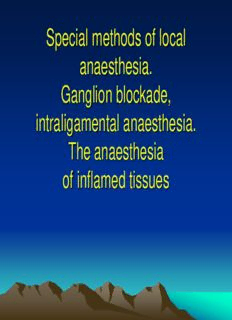
Local anaesthesia IV. Special methods of local anaesthesia. Ganglion blockade, intraligamental PDF
Preview Local anaesthesia IV. Special methods of local anaesthesia. Ganglion blockade, intraligamental
Special methods of local anaesthesia. Ganglion blockade, intraligamental anaesthesia. The anaesthesia of inflamed tissues Types of local anaesthesia Terminal anaesthesia a. mucosal anaesthesia b. submucous infiltration c. subperiosteal infiltration d. intraligamental anaesthesia Block (conductive) anaesthesia Ganglion blockade Special techniques of local anaesthesia • Anaesthesia of the long buccal nerve It innerves the buccal mucosa from the midline of the second premolar backwards to the midline of the third molar. It can be anaesthetised in the area of the retromolar triangle Only needed if a mucosal incision is performed, too!! Special techniques of local anaesthesia • Anaesthesia of the long buccal nerve Special techniques of local anaesthesia • Anaesthesia of the mental nerve Used separately very rarely (instead of block anaesthesia) The solution is injected between the two lower premolars from the direction of the first molar. If necessary the foramen can be touched and 0.5-1 ml solution can be injected directly into it. Special techniques of local anaesthesia • Anaesthesia of the mental nerve Special techniques of local anaesthesia • Common anaesthesia of the lower alveolar nerve, the lingual nerve and the long buccal nerve The needle is not fully pulled out after block anaesthesia. Leaving the tip of the needle in the mucosa (2mm) we inject the rest of the solution into the retromolar triangle. Special techniques of local anaesthesia • Anaesthesia of the infraorbital nerve May be extra- or intraoral (block). This method can be used in patients with trigeminal neuralgia (as well) Finding the infraorbital foramen: horizontal plane→ 1 cm below the infraorbital margin vertical plane→ line of the pupil-second upper premolar Special techniques of local anaesthesia • Anaesthesia of the infraorbital nerve Special techniques of local anaesthesia • Matas anaesthesia The trunk of the maxillary nerve is anaesthetised by reaching into the pterygopalatine canal (block) A long needle bent in 45 degrees is inserted through the greater palatine foramen into the canal. There we proceed approximately 3 cm. Indication: partial removal of the maxilla, operations in the maxillary sinus….. Localising the greater palatine foramen: Gyergyai’s method, or in the imaginary line connecting the distopalatinal cusps of the upper second molars, at 1 cm from the margin of the gingiva.
Description: